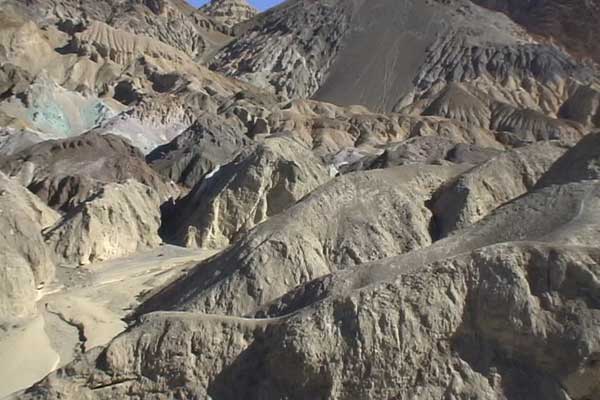I’ve always been a fan of desserts for their serene landscapes and shy but hardy flora and fauna. Starkly named and offering dreamlike scenery, Death Valley is the largest national park in the 48 states and has both the uniformity and variety that I was craving.
The best part about Death Valley would have to be driving through the lonely roads with unobstructed views of the mountains and the dessert landscape on either side. Most of the roads are well maintained, numerous small hills and changes in elevation provide an exhilarating ride for those who enjoy being behind the wheel. A highlight was a strip on I-190 where only a guard rail protects you from a drop into the canyon. You corner a massive turn while the west side of the National Park comes into view, a band of highway bisecting a perfectly flat sun kissed land. Tumble weeds, cacti and other plants dot the landscape in an almost checkerboard fashion. Stove Pipe Sand Dunes arrive on your right side and you can stop if you haven’t seen enough sand dunes. (I have, see Nubra Valley in the Himalayas section)
In December, weather forecasts predicted a high of 74 Degrees Fahrenheit. However, once the sun came out it in the mid afternoon the temperature seemed far higher. I arrived in the park on a Monday, so perhaps traffic was lesser than on a weekend, but for miles on end I hardly saw a car which was a refreshing break from the city.
Badwater is the lowest point in the Western Hemisphere, about 282 feet below sea level, with signs and appropriate landmarks denoting the area. It is an eye opener to see the beige and ochre hills in the distance and then an even white sheet covering a valley that goes on as far as the eye can see. The whiteness is actually salt from a dried lake, and you can walk out into the lake bed.
I met some geology students who were mapping the surface layers of Death Valley when I arrived at Badwater. I followed them out to a small metallic structure made of tubes and rods, perhaps a left over from a previous experiment. The salt was compact and crunched under my feet, leaving cakes on my shoes and pants. This is what Antartica must feel like, I thought.
A turn off after Badwater is Artist’s Road, which is just a wonderful drive on a back road. The drops are quite steep so drive slowly, but you are rewarded with a feeling of being truly in the middle of nowhere with large canyons on either side, hills and oddly contoured rocks that you can reach out and touch. The drive leads to Artist’s Palette, which as its name implies, is a canvas of hills and rocks that are naturally pigmented, orange, green, red, blue, and a whole rainbow of colors.
If I had more time I wish I had been able to hike through some of the trails that cropped up at various points along the drive. Also Ghost Town and mining outposts appear at intervals along the rode and you can turn off and explore how the gold miners and Shoshone Indians lived. The road leading up to the popular Dante’s View was closed and supposedly this is where you can view some of the highest and lowest points of Death Valley including Badwater.
Friendly Park Rangers can point you in the right direction at the Furnace Creek Visitor Center. Just make sure you have bought your park pass or buy it here. The movie screened every 30 minutes at the Visitor Center is a somewhat hilarious send up to Death Valley. The movie instructs you in a somewhat 1950’s Leave it to Beaver style about pup fish, pinyon nuts and the history of the valley.
A Park Ranger advised me to visit Zabriskie Point, a beautiful spot where you can clearly see the changes of texture in the rock, some ribboned and flowing like someone had ran a fork through pudding, and others more tall and sharp.
k
|















